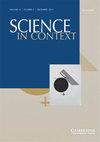"Please, come in." Being a charlatan, or the question of trustworthy knowledge.
IF 0.5
4区 哲学
Q2 Arts and Humanities
引用次数: 0
Abstract
With these words from the 1860s, Guido Bennati (1827–1898), an ambulant quack from Pisa, introduced himself at his arrival at the market places in the Italian Piedmont. By calling himself a charlatan, Bennati did not disqualify his art. He called his profession by its real name, and he underscored its value: he was a self-styled practitioner in the lower regions of the medical profession who, in Italy, during the time of the Risorgimento, were still licensed to sell some kinds of external remedies and to perform external operations. They seemed to be making themselves heard everywhere. From England to Italy, from France to Spain and the Americas, markets and newspapers were filled with their advertisements and remedies. “Charlatan,” while a profession, meant something different in other linguistic contexts. Just across the border, in France, the journalist and writer Jean-Baptiste Gouriet (1774-1855) had published a compilation of the most famous charlatans that visited Paris from ancient times to the present day. In so doing, he specified that the term included the jugglers, jokers, jesters, operators, acrobats, crooks, swindlers, soothsayers, card-pullers, fortune-tellers and all the characters who have made themselves famous in the streets and public squares of Paris. Gouriet connected their stories to the history of theatre, entertainment, and illusion, but also to their use of the public space and their itinerant life (Gouriet 1819). Traveling from one marketplace to another, dealing in exotic objects and remedies, organizing shows and exhibitions, performing miraculous healings by appealing to the curative power of words and liniments, charlatans have infested Paris and traversed Europe at least since early modern times. The category included advocates for the elegant dog, the sage donkey, and the talking horses, a conversation that – as Daniel Gethmann shows in his article below – made its way into the scientific debates of the twentieth century. In that sense, tracing the history of charlatans and talking horses can be a means of seeing and understanding the changing frontiers of science. As Nathalie Richard develops in her epilogue, the science of modern charlatans syncretizes elements of a popular culture that far from having “no history” is rather constituted with elements borrowed from the cutting edge of the modernity of its time. As the classic mountebank he was, Bennati arrived in the Italian towns accompanied by a parade of exotically dressed musicians and entertainers (Fucini 1921, translated by and quoted in Gambaccini 2004, 200). Like many other European traveling doctors, Bennati appealed to “drum and trumpet” theater performances, old routines that in the nineteenth century had incorporated the “ethnographic parade,” in the style of Phineas Taylor Barnum’s circus, which originated in the US as traveling medicine shows: the association of a “doctor” with a Native“请进。”做一个江湖骗子,还是可信知识的问题。
本文章由计算机程序翻译,如有差异,请以英文原文为准。
求助全文
约1分钟内获得全文
求助全文
来源期刊

Science in Context
综合性期刊-科学史与科学哲学
CiteScore
0.80
自引率
0.00%
发文量
1
审稿时长
>12 weeks
期刊介绍:
Science in Context is an international journal edited at The Cohn Institute for the History and Philosophy of Science and Ideas, Tel Aviv University, with the support of the Van Leer Jerusalem Institute. It is devoted to the study of the sciences from the points of view of comparative epistemology and historical sociology of scientific knowledge. The journal is committed to an interdisciplinary approach to the study of science and its cultural development - it does not segregate considerations drawn from history, philosophy and sociology. Controversies within scientific knowledge and debates about methodology are presented in their contexts.
 求助内容:
求助内容: 应助结果提醒方式:
应助结果提醒方式:


